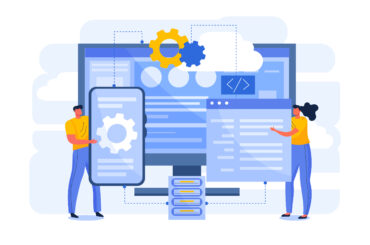What is Headless Magento? A Brief Guide!
Last Updated | October 31, 2023
Table of Contents
In the ever-evolving world of e-commerce, staying ahead of the curve is imperative. One of the latest trends making waves in the industry is “Headless Magento.” If you’ve heard this term and wondered what it’s all about, or if you’re looking to explore the possibilities it offers, you’re in the right place.
Well, in this brief guide, we will try to explore the Headless Magento, explaining what it is, why it matters, and how it can benefit your e-commerce business. So, what’s the wait? Let’s get started…
What is Headless Magento?
At its core, Headless Magento refers to decoupling the front-end (the “head”) of your e-commerce store from the back-end, which includes the content management system, database, and logic. With a traditional Magento setup, the front-end and back-end are tightly integrated, which can limit flexibility and customization. Headless Magento liberates your front end from these constraints, allowing it to be independent and more versatile.
Why Headless Magento Matters
Headless Magento matters because it opens up a world of opportunities for e-commerce businesses. By separating the presentation layer (the front end) from the underlying business logic (the back end), you gain greater control over your customer experiences. It empowers you to provide tailored, responsive, and immersive shopping experiences, which are increasingly critical in the competitive e-commerce landscape.
Understanding the Basics
To truly grasp the concept of Headless Magento, we got to explore deeper into the foundational aspects of this innovative approach.
Let’s explore the working of Magento Headless by understanding the basics and comparing Magento Headless with traditional Magento, so you can make informed decisions regarding the implementation of Headless Magento in your e-commerce ecosystem.
Traditional vs. Headless Architecture
In the traditional e-commerce setup, the front end and back end are tightly intertwined. This means that any changes or customizations made to the front end can have cascading effects throughout the system. On the other hand, Headless Magento introduces a fundamental shift by decoupling the front-end and back-end components of your e-commerce platform.
Traditional Architecture:
- The front-end and back-end are tightly connected.
- Changes to the front end can impact the back end.
- Limited flexibility in adapting to new technologies.
Headless Architecture:
- Separation of the front-end and back-end.
- Independent development of the front-end and back-end.
- Allows for diverse technologies on the front end without affecting the back end.
How Headless Magento Works
Headless Magento’s functionality hinges on the use of APIs (Application Programming Interfaces) that facilitate communication between the front-end and back-end systems. This separation is the core tenet of Headless Magento and allows for the independent development and evolution of both layers, resulting in several significant benefits:
- Front-End Flexibility: With the front-end decoupled from the back-end, you have the freedom to choose various front-end technologies, including Progressive Web Apps (PWAs), mobile apps, or custom web experiences, without affecting the underlying business logic.
- Performance Optimization: The independent optimization of both the front-end and back-end leads to better performance. Faster loading times, improved SEO, and a more responsive user interface are among the advantages.
- User Experience Enhancement: Headless Magento empowers you to create a consistent and tailored shopping experience across diverse touchpoints, ensuring that your customers receive a seamless experience whether they shop on a desktop, a mobile device, or in a physical store.
Benefits of Going Headless
Enhanced Flexibility
Headless Magento offers unparalleled flexibility. You can use various front-end technologies, from Progressive Web Apps (PWAs) to mobile apps and custom web experiences, without affecting the back-end. This flexibility means you can quickly adapt to changing customer preferences and market trends.
Superior Performance
With a decoupled architecture, your e-commerce store can achieve better performance. This is because you can optimize both the front-end and back-end independently, resulting in faster loading times, improved SEO, and a more responsive user interface.
Seamless Omnichannel Experiences
Headless Magento enables you to create seamless omnichannel experiences. Whether your customers are shopping on a desktop, mobile device, or in-store, you can deliver a consistent and tailored experience across all touchpoints.
Is Headless Magento Right for Your Business?
Well, as we move deeper into understanding the working and benefits of Magento 2 headless, let’s explore how to identify if headless Magento 2 is the right choice for your business. Now, the key here for businesses is to be well-informed about their unique business needs along with several other considerations, including:
Assessing Your Business Needs
Before deciding whether to go Headless, take a close look at your e-commerce goals, challenges, and customer expectations. The suitability of headless commerce Magento for your business hinges on several crucial aspects:
- Flexibility: Consider whether your business requires the flexibility to adapt to rapidly changing customer preferences, new technologies, and emerging market trends. Headless architecture allows you to evolve your front end without affecting your back end, providing a valuable edge in a dynamic e-commerce landscape.
- Performance: Think about the significance of superior performance for your online store. If you prioritize faster loading times, improved SEO, and a responsive user interface, Headless Magento might align perfectly with your performance objectives.
- Omnichannel Experiences: Evaluate whether your customers interact with your brand through multiple channels, such as desktop, mobile devices, and physical stores. Headless Magento enables you to offer a seamless and consistent shopping experience across all touchpoints.
Key Considerations Before Going Headless
The transition to Magento headless commerce is a significant decision and should not be taken lightly. Several critical considerations come into play:
- Complexity: Assess the complexity of your e-commerce project. Large, intricate projects with diverse front-end requirements can benefit most from Headless Magento. Smaller, straightforward projects might not require the added flexibility of a Headless setup.
- Resources: Consider the availability of resources, both in terms of development expertise and budget. While Headless Magento offers substantial benefits, it can also involve more development complexity, which requires a skilled team.
- Technical Expertise: Evaluate your team’s technical expertise. Headless Magento involves working with various technologies and APIs, so it’s essential to ensure your team or partner agency has the required skill set.
- Feasibility: Assess the feasibility of the transition. Determine if your existing systems, such as content management and inventory management, can smoothly integrate into a Headless Magento setup.
- Customization Needs: Analyze the level of customization required for your e-commerce store. If your business demands a unique and tailored shopping experience, Headless Magento can provide the necessary flexibility.
Implementing Headless Magento
Well, as we move further into our guide introducing the Magento headless, we are sure that by now, you will be much aware that this unique framework suits your business needs. Now, let’s move on and see how you can implement headless Magento 2.
Honestly, headless Magento implementation is a complex process and thereby, we highly recommend you hire an expert Magento development partner who can help streamline the process for your business. Nonetheless, let’s explore briefly the steps that can help you streamline the implementation process:
Steps to Transition
The implementation of Headless Magento involves the following crucial steps:
- Project Assessment: Before diving into the transition, thoroughly assess your e-commerce project. Understand the complexities and unique requirements of your project, as this assessment will guide your approach.
- Front-End Technology Selection: Select the appropriate front-end technology that aligns with your goals. This could include building a Progressive Web App (PWA), developing a mobile application, or creating a custom web experience. Each choice has its own merits and considerations.
- API Setup: APIs (Application Programming Interfaces) are the backbone of Headless Magento. Establish robust API connections between the front-end and back-end to enable seamless communication. This step is essential for data transfer and functionality.
- Front-End Customization: Tailor your chosen front-end technology to meet your unique business requirements. This customization allows you to create a user interface that aligns perfectly with your brand and provides an exceptional shopping experience for your customers.
- Testing and Quality Assurance: Rigorous testing and quality assurance are paramount. Ensure that your Headless Magento setup functions flawlessly, provides superior performance, and offers an optimal user experience.
- Data Migration: Migrating data from your previous e-commerce setup to Headless Magento is a critical step. Data accuracy and integrity are vital for a successful transition. Your product listings, customer data, and order history need to be seamlessly transferred.
- Content Management: Manage your content efficiently in a Headless Magento environment. Implementing a suitable content management system (CMS) and ensuring its compatibility with Headless architecture is crucial for content updates and modifications.
- Team Training: Equip your team with the knowledge and skills required to operate in a Headless environment. Training ensures that your team can effectively manage and maintain the new setup.
- Ongoing Maintenance: A Headless Magento setup requires ongoing maintenance to keep your online store running smoothly. Regular updates, security patches, and performance enhancements are essential.
Common Challenges and How to Overcome Them
As a complex framework, there certainly are various challenges involved in Magento headless implementation. Let’s explore some of the more common challenges and how you can overcome them during the implementation phase:
Increased Development Complexity: Headless Magento introduces more development complexity due to the use of APIs and front-end technologies. The solution is to work with an experienced team of Magento developers who understand the intricacies of Headless architecture.
Integration Issues: Integrating various systems, such as content management and inventory management, can be challenging. Overcome this challenge by ensuring compatibility and effective data transfer between systems.
Resource and Budget Constraints: Implementing Headless Magento might require additional resources and budget. Careful resource allocation and budget planning are essential. Consider the long-term benefits in terms of flexibility and performance.
Quality Assurance: Rigorous testing and quality assurance are crucial but can be time-consuming. Invest the necessary time and resources to ensure a flawless transition.
Content Management: Efficient content management in a Headless setup is vital. Choose a CMS that seamlessly integrates with Headless Magento and supports your content needs.
Headless Magento and the Future
In the rapidly evolving landscape of e-commerce, staying ahead of the curve is not merely a desire but a necessity for businesses aiming to thrive and grow. “Headless Magento” is not just a trend of the present; it’s a forward-thinking approach that can pave the way for your e-commerce business to adapt, excel, and secure its position in the future.
Let’s explore what Headless Magento means for the future of e-commerce.
Adapting to Changing Consumer Expectations:
Consumer preferences can change swiftly, and your ability to cater to these shifts is vital. Headless architecture offers the flexibility needed to create, modify, and optimize your front-end experiences rapidly.
Staying at the Forefront of Technology:
As new technologies emerge, integrating them into your e-commerce ecosystem becomes essential. Headless Magento provides the perfect environment for embracing cutting-edge technologies, such as augmented reality (AR), virtual reality (VR), and voice commerce.
Scaling with Ease:
Scalability is a hallmark of a Headless Magento setup. As your business grows, you can effortlessly scale your infrastructure and adapt to increasing demand, all while maintaining optimal performance and user experiences.
Ensuring Cross-Channel Consistency:
With the proliferation of multiple sales channels, maintaining a consistent brand image and shopping experience is challenging. Headless Magento empowers you to provide a uniform and tailored experience across diverse touchpoints, including desktop, mobile devices, social media, and physical stores.
Conclusion
Headless Magento is not just a buzzword; it’s a game-changing approach to e-commerce. By decoupling your front-end and back-end, you gain the flexibility, performance, and agility needed to succeed in a competitive online marketplace. If you’re ready to explore the possibilities of Headless Magento for your e-commerce business, reach out to us at Folio3. We have the expertise and experience to help you make a seamless transition.









